Lowestoft War Memorial Museum
The Lowestoft War Memorial Museum is a museum located in Lowestoft in the English county of Suffolk. It is housed in the World War Two headquarters of the Royal Naval Patrol Service in Sparrows Nest Gardens in the north of the town. The museum is dedicated to all of the people of Lowestoft who served during World War One and World War Two. It was opened in 1995,[1] to coincide with the 50th anniversary of VE day on 8 May that year.[2]
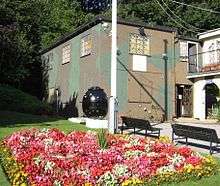 An early photograph of the Lowestoft War Memorial Museum | |
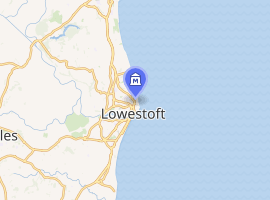
| |
| Established | 8 May 1995 |
|---|---|
| Location | Sparrows Nest Gardens, Lowestoft, Suffolk |
| Coordinates | 52.4875°N 1.756°E |
| Curator | Robert Jarvis |
| Website | www.lowestoftwarmemorialmuseum.co.uk |
The museum is operated by volunteers and is open on some weekends and school holidays during the summer period.[2] Inside the museum is a small chapel and the roll of honour for civilians killed by enemy action in Lowestoft during both World Wars. There are numerous exhibits and photographs, including many that relate to the wartime defences of the town and the effect on the town and its population of the destruction caused by enemy bombing. Other artifacts and photographs tell the stories of the servicemen and women who either served in, or who came from, Lowestoft.[3]
The museum can be visited on Sunday and Bank holiday afternoons from May to October. There is a small entry charge.
History
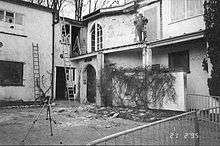
Sparrows Nest originally formed the grounds and formal gardens to the early 19th century thatched summer residence of Robert Sparrow, a local wealthy landowner.[4] The local council bought the gardens in the 1890s.[5] The gardens became a popular venue for concerts and, in 1913, the Borough of Lowestoft commissioned the 1300-seat Pavilion Theatre in the gardens.[6]
The museum building was built by the Royal Navy as an extension to the house following the commandeering of the site as the headquarters and central depot for the Royal Naval Patrol Service in September 1939.[5][6] The thatched two storey residence was demolished by the local authority in the 1960s, leaving the brick and concrete extensions which now form the Lowestoft War Memorial Museum, the Royal Naval Patrol Service Museum and a café.[7]
Prior to its restoration in the 1990s, the building had become dilapidated, with a downstairs room (once used as a Suffolk Wildlife Trust office) being in a reasonable condition, but the upstairs room, that had been used to store theatrical props, needing a lot of work. Funds for the refurbishment of the building, which cost £23,000, were largely raised by Jack Rose, through the sales of his local history books and by his popular slide shows.[7]
Exhibits
 A World War II air raid siren, now housed in the museum.
A World War II air raid siren, now housed in the museum.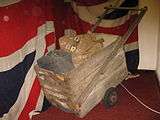 Original example of a barrow used by boys in Lowestoft to transport servicemen's belongings.
Original example of a barrow used by boys in Lowestoft to transport servicemen's belongings.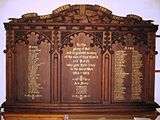 Memorial board kept in the museum's chapel.
Memorial board kept in the museum's chapel..jpg) A photograph of HMS Europa. The sailors are waiting to be given their draft or ship by an officer.
A photograph of HMS Europa. The sailors are waiting to be given their draft or ship by an officer.
References
- Lowestoft War Memorial Museum needs volunteers Archived 27 March 2014 at the Wayback Machine, accessed 27 March 2014.
- Lowestoft war museum needs you!, Lowestoft Journal, 3 March 2014. Accessed 29 March 2014.
- Vessey, The Hidden Places of East Anglia, p. 174.
- The Sparrows of Worlingham
- Sparrows Nest Park Archived 29 March 2014 at the Wayback Machine, Waveney District Council. Accessed 29 March 2014.
- BBC Suffolk – Where I Live
- Rose, J. Jack Rose's Lowestoft Picture Book.
- Rose, Jack (1998). Jack Rose's Lowestoft Picture Show. Lowestoft: Rushmere Publishing. ISBN 1 872992 12 9.
- Vessey, Barbara, ed. (2003). The Hidden Places of East Anglia: Including Essex, Suffolk, Norfolk and Cambridgeshire (7th ed.). Aldermaston, UK: Travel Publishing Ltd. ISBN 1-902-00791-3.